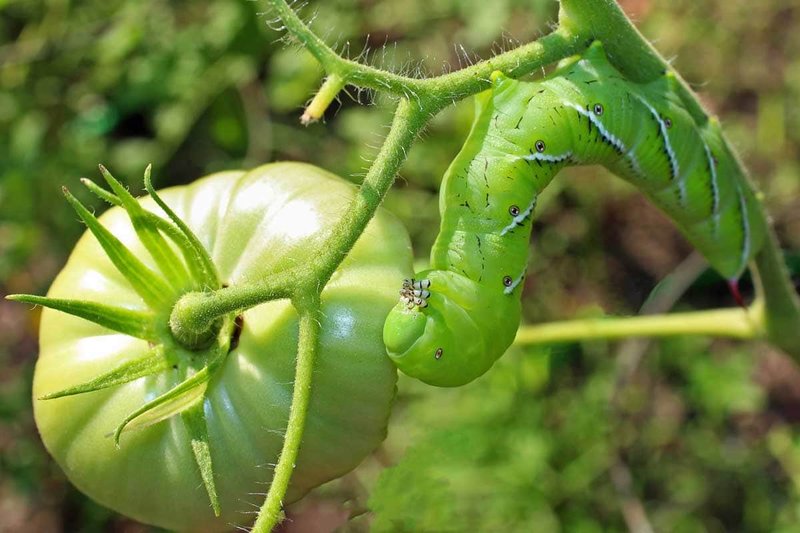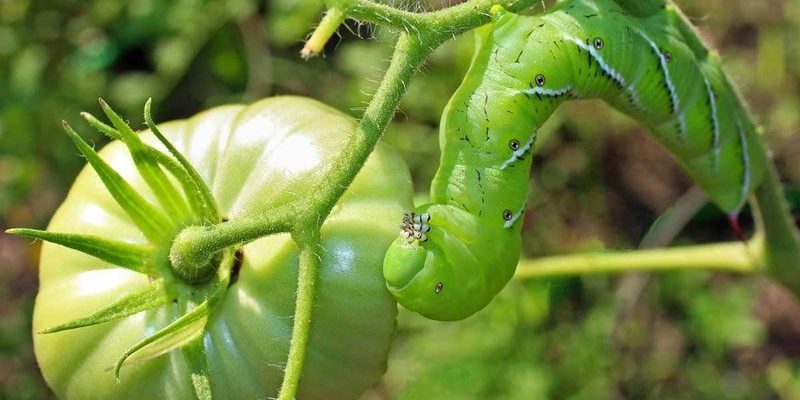
You might be thinking, “What even is a hornworm?” Well, let me explain. Hornworms are the larval stage of certain moths, including the tomato hornworm and the tobacco hornworm. They can grow quite large, sometimes reaching up to four inches! When they decide to take a bite out of your crops, they can cause significant damage, which is a real bummer for any gardener. We’ll explore why these little guys are such a problem, how to identify them, and, most importantly, how to tackle their invasion.
What Are Hornworms?
Hornworms are the larvae of large moths, particularly the five-spotted hawk moth and the tobacco hornworm moth. They’re named for the horn-like structure on their rear end, which gives them a unique look—almost like they’re wearing a tiny crown. These caterpillars come in a striking green color, making them hard to spot against the foliage of plants.
You might encounter two main types of hornworms in your garden: the tomato hornworm, which primarily feasts on tomatoes and peppers, and the tobacco hornworm, which prefers tobacco but is not picky when it comes to other plants. Both types can wreak havoc on tomato, pepper, and eggplant crops.
Their life cycle starts when adult moths lay eggs on the undersides of leaves. Once the larvae hatch, they start munching away, growing rapidly as they feed. They can consume a shocking amount of foliage in just a few days, which is why early identification is crucial for protecting your plants.
Signs of Hornworm Infestation
You might be wondering how to spot these sneaky pests before it’s too late. One of the most visible signs of a hornworm infestation is the obvious damage to your plants. Here’s what to look for:
- Chewed leaves: Hornworms love to munch on the leaves, leaving large holes. If you see big chunks missing, that’s a red flag.
- Green droppings: Look for tiny green pellets on the ground or on the leaves. These are the telltale signs of hornworm munching.
- Presence of the worm: Sometimes, the most straightforward sign is actually seeing the caterpillar itself. They can be camouflaged, but keep an eye out for their large size and distinctive horn.
- Yellowing or wilting: If the plant’s health is declining quickly, it may be due to hornworms draining its vitality.
Keeping a close eye on your plants is essential. If you notice any of these signs, it’s time to take action before they do further damage.
Impact on Tomato, Pepper, and Eggplant Crops
Hornworms are especially fond of tomatoes, peppers, and eggplants, and their impact can be devastating. Picture this: you’ve tended to your garden all season—watering, weeding, and waiting for your crops to flourish. Then, you discover your prized tomatoes have been turned into a buffet for hornworms!
The damage can vary, but here’s what you might experience:
1. Reduced yield: Hornworms consume a lot, which means less fruit for you. A single caterpillar can devour a significant portion of a plant’s leaves, stunting growth and reducing overall yield.
2. Disease susceptibility: Damaged plants are more prone to diseases. If the leaves are torn, it creates entry points for fungi and bacteria, which can lead to further complications.
3. Aesthetic damage: Even if just one or two hornworms are present, the visual damage can be disheartening. Holes in beautifully ripening fruits can make harvesting feel less rewarding.
In short, hornworms can take away the pleasure of a fruitful harvest and turn your gardening dreams into a nightmare.
How to Identify Hornworms
Identifying hornworms isn’t just about spotting the damage; it’s also about knowing what you’re up against. Here are some key identification tips:
1. Color and size: As I mentioned earlier, hornworms are generally green and can grow up to four inches long. Their large size, coupled with a horn-like protrusion, makes them stand out—once you spot them!
2. Movement: If you happen to brush against a leaf, a hornworm will often drop to the ground or try to blend in, thinking it’s hiding. Keep your eyes peeled for any sudden movements in your plants.
3. Camouflage: Their green color helps them blend in with the foliage, but they can sometimes have slight variations, like faint stripes or spots. Look closely at the undersides of leaves, where they often hide.
4. Moth presence: If you see large moths flying around your garden, it’s a good sign that hornworms may soon be on the way. Keep an eye on the activity around your plants.
Recognizing the signs of hornworms early gives you a better chance of managing them effectively.
How to Control Hornworm Populations
Dealing with hornworms can feel overwhelming, but there are several effective strategies to keep their populations in check. Here’s how to tackle the issue head-on:
1. Handpicking: This is the simplest and most immediate method. Wear gloves and inspect your plants regularly, especially in the morning or evening when the hornworms are more active. If you find any, just pluck them off and either relocate them far away or dispose of them.
2. Natural predators: Encourage beneficial insects in your garden. Birds, wasps, and other predatory insects are hornworm hunters! You can attract them by planting flowers or herbs nearby.
3. Insecticidal soap: If the infestation is large, consider using insecticidal soap. It’s a less toxic option that can help manage the population without harming beneficial insects. Be sure to follow the instructions carefully and avoid applying it in the heat to prevent plant damage.
4. Neem oil: This natural pesticide disrupts the hornworms’ feeding and reproduction. Spray it on the affected plants, focusing on the undersides of leaves where hornworms tend to hide.
5. Crop rotation: Practicing crop rotation can be a long-term strategy against hornworms. By changing the location of your plants each year, you disrupt the life cycle of the pests, making it harder for them to come back.
Take a multi-faceted approach for the best results. You’ll feel more in control and can enjoy your garden again!
Hornworms can pose a significant threat to your tomato, pepper, and eggplant crops, but with the right knowledge and strategies, you can effectively manage their impact. By regularly checking your plants, implementing control measures, and being aware of the signs of an infestation, you can protect your garden from these pesky invaders. Remember, every gardener faces challenges, but by learning how to handle hornworms, you’ll be better equipped to enjoy a bountiful harvest next season. So grab your gardening gloves and get out there—your plants are counting on you!

